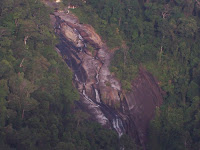The name "Langkawi" is believed to be related to the kingdom of Langkasuka, centred in modern-day Kedah. The historical record is sparse, but a Chinese Liang Dynasty record (c. 500 AD) refers to the kingdom of "Langgasu" as being founded in the 1st century AD. 'Langkawi' mean's Eagle Island, it may be noted, and indeed there is a great abundance of eagles in the area. In Kuah, there is an eagle monument in Eagle Square which commemorates the origin of Langkawi's name. Langkawi is also the site of the Mahsuri Legend. The legend speaks of a young woman who was accused of adultry and was executed by the public despite her pleading innocence. Mahsuri, before her death, made a curse on the island for seven generations of bad luck. Langkawi eventually came under the influence of the Sultanate of Kedah, but Kedah was conquered in 1821 by Siam and Langkawi along with it. The Anglo-Siamese Treaty of 1909 transferred power to the British, who held the state until independence, except for a brief period of Thai rule under the Japanese occupation of Malaya during WW II. Thai influences remain visible in the culture and food of Langkawi.
Beautiful place to visit....
1. Langkawi cable car

























































